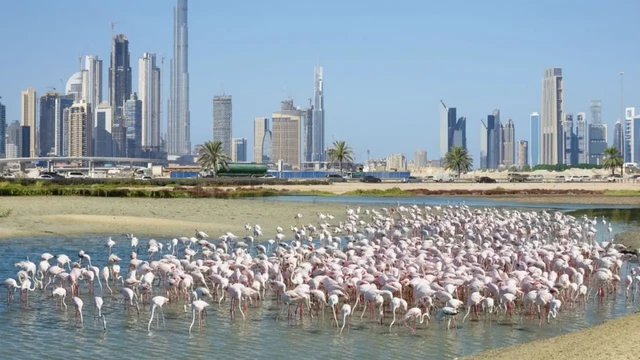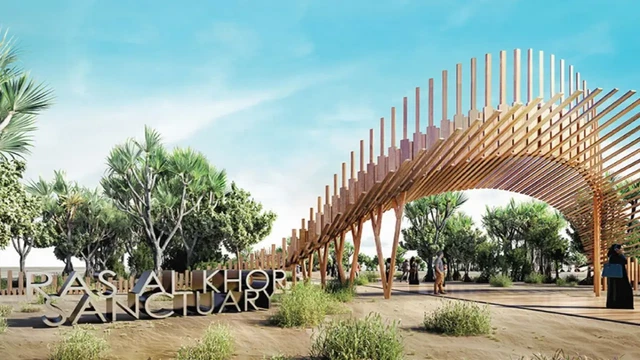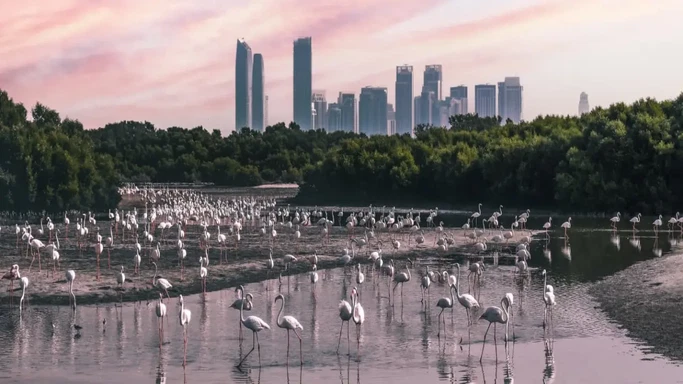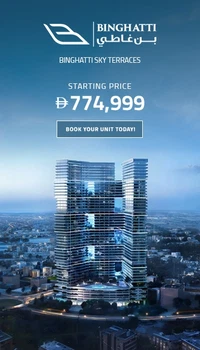Ras Al Khor Sanctuary, often called “The Cape of the Creek”, is one of Dubai’s most popular attractions. Just minutes away from the city’s soaring skyscrapers, this natural reserve hosts a wide range of wildlife, including the world-famous flocks of flamingos.
Besides its international significance as a famous attraction, the site also provides a rare glimpse into Dubai’s biodiversity, making it a must-visit place for photographers, birdwatchers, and eco-tourists.
History & Importance
Ras Al Khor Wildlife Sanctuary is one of the earliest conservation projects to be launched in Dubai in 1985. It is named after the geographical feature: Cape of the Creek, because the place lies at the edge of the Dubai Creek, a meeting point of fresh and saltwater to form a rich wetland. The sanctuary has, over the years, been a very vital point of stopover to thousands of migratory birds that move between Asia, Europe, and Africa.
Wildlife Sanctuary Dubai: Wildlife & Biodiversity
1. Birdlife: The Star Attraction
Wildlife Sanctuary Dubai stands out for greater flamingo flocks, presenting a picturesque scene, especially in the winter season. Additionally, the sanctuary is home to more than 450 species of birds, including ospreys, marsh harriers, egrets, and black-winged stilts. Link The migratory visitors and resident species will flourish here throughout the year, and the birdwatchers will be delighted.
2. Beyond the Birds
Although the sanctuary is also known for its bird life, it is also home to various other animals. The food chain is based on the richness of the wetlands in fish, crabs, mollusks, and insects. The area also has small mammals and reptiles, which contribute to the ecological balance of the sanctuary.
3. Seasonal Diversity
Among the most interesting things about Ras Al Khor is the seasonal wildlife. Migratory birds come during winter, and welcome thousands of visitors for a panoramic experience. Summer, in turn, is when more resident species use the mangroves and mudflats as sources of food and refuge.
Notable Species at Ras Al Khor Wildlife Sanctuary

You will be astonished when you find the abundance of flora and fauna surrounding you as you take a casual stroll. Some of the birds and animals that have attracted our attention are listed below:
- Flamingos - The largest attraction in the sanctuary, thousands of greater flamingos come here to feed on the wetlands during winter and make the wetlands turn pink.
- Ferruginous Duck - This is a very rare migrant duck, frequently seen at Ras Al Khor, which is unique by virtue of its rich chestnut coloration and by its near-threatened status.
- Ethiopian Hedgehog - This is a small creature discovered at night. The Ethiopian hedgehog is an active creature that will hide in the quieter parts of the sanctuary and shelter under the shrubs and dine on insects.
- Blue Swimming Crab - It has very bright blue claws and lives in a lagoon where it is one of the most important contributors to the food chain of the wetland.
- Mozambique Tilapia - The Mozambique tilapia is a strong freshwater fish, and it can freely adapt to brackish water bodies, hence it can readily be found in Dubai Creek and the sanctuary.
- Tigerfish - This species is easy to recognize by its sharp teeth and stripes that cover its body, and it adds to the diversity of aquatic life at Ras Al Khor.
- Blue-headed Agama - This is a very bright lizard with bright head colour, as often found on rocks and walls, as it is often found in dry parts of the sanctuary.
- Fringe-toed Lizard - This lizard is most adapted to the sandy terrain, and it relies on its fringe toes to move over the desert flats that encircle the wetlands within a short time.
Habitats & Ecosystem

1. Mudflats and Lagoons
The broad mudflats and the shallow lagoons of Ras Al Khor are the centre of the destination. These ponds constitute feeding grounds of thousands of migratory birds, particularly flamingos, which feed on the soft mud, retrieving shrimps and algae. The fish and crabs also inhabit the peaceful lagoons, forming the food web’s foundation.
2. Mangroves
At the creek banks, there are patches of mangroves, which naturally breed fish, crustaceans, and also a natural breeding ground for the various species of birds. Their heavy roots stabilize the ground, stop erosion, and make good filters that keep the water clean.
3. Salt Flats (Sabkhas)
In the sanctuary, there are sabkha, or salt flats, that, though uninviting at a glance, are crucial resting places of the waders and nesting ground-dwellers. These extreme conditions are favorable to the existence of special plants and those reptiles that are adapted to severe environments.
4. Interconnected Ecosystem
It is the equilibrium of these habitats that makes Ras Al Khor so special. Mudflats support the birds, mangroves support young aquatic life, and salt flats provide nesting and resting sites. They all offer ecosystems of immense power thriving off the spectacular biodiversity at the core of Dubai.
Conservation Efforts
Ras Al Khor Wildlife Sanctuary Dubai is a well-kept ecosystem managed by the Dubai Municipality. The conservation rules are stringent, regulating visitors’ activities in the wetland.
In 2007, the sanctuary was designated as an official Ramsar Site, which surfaced its recognition internationally. Ever since that, attempts at habitat restoration have continued in an unbroken effort to keep track of water quality and species protection.
Furthermore, educational talks and programs raise awareness among visitors and residents regarding wetland’s positive impact on climate change.
Ras Al Khor Wildlife Sanctuary Ticket Prices and Booking Information
Timings
- 7:30 am-5:30 pm (October to March)
6 am-6 pm (April to September)
Entry Fee: Free of Cost
- Guided Tours: 7.30 am to 2 pm (Sunday to Thursday)
- Note: Educational tours can be confirmed via [email protected].
- Contact: Dubai Municipality Helpline - 800900
How to get to Ras Al Khor Wildlife Sanctuary
The wildlife Sanctuary, Ras Al Khor, may be accessed by the following modes of transportation:
- Although there is no metro station near the sanctuary, you can get halfway there by taking the metro. Ride the Green Line and get off at the Al Jadaf or Creek metro station, and get a taxi to make a short ride to Ras Al Khor Wildlife Sanctuary.
- Alternatively, when you are on the road, e.g., heading out of Mall of the Emirates, take Sheikh Zayed Rd/E11 to Al Meydan Rd/D69. Get off at exit 47 on Sheikh Zayed Rd/ E11 and take off on Al Khail Rd/ E44 and proceed until you reach the sanctuary.
Tips for Visitors
- Bring Binoculars or a Zoom Lens- This is necessary for bird watching and to take close-ups without scaring the animals.
- Plan Around Opening Times - Open most of the time; always check a schedule before you visit.
- Comfortable Clothing - Wear loose garments, hats, and sunscreen (during the warmer months only).
- Follow the Rules - Do not eat, litter, or make noise. The sanctuary is a sacred place.
- Parking and Access - There is limited parking close to the bird hides, so you need to plan how to get there.
Closing In
Ras Al Khor Wildlife Sanctuary in Dubai is evidence that in the city of the future, skyscrapers and busy streets, nature is alive. Having flocks of flamingos, various birdlife, and rich ecosystems of the mangroves, mudflats, and lagoons, it offers a rare glimpse of Dubai’s wild side.
Beyond a tourist attraction, the site reflects how the city has put in efforts to conserve and provide harmony in terms of development and preservation.
Explore More...
- About IMG Worlds of Adventure in Dubai
- Reasons Why You Should Invest in Dubai Real Estate
- Best Shopping Malls in Dubai
- Dubai Metro: Timings, Rules, and Lines
- A Complete Guide to Public Transport in Dubai
- Everything About Dragon Mart
- Things to do in Old Dubai
- Future of Dubai South: The Upcoming Real Estate Trend Next to Al Maktoum Airport
- Top Off-Plan Projects by Imtiaz






